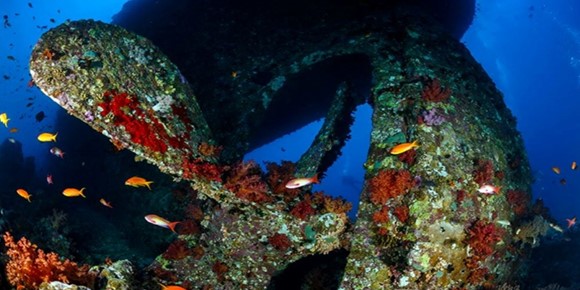Overview
The steam sailer Carnatic was launched in Poplar, England, on December 8, 1862, for the famous British shipping company P&O Company. The name comes from a region in India. The 98 m long and 13 m wide steam sailer showed in its lines the classical beauty of sailing ships of its time. Despite her steam engine, the Carnatic still carried two masts for auxiliary sailing. The shipping company used the ship on scheduled services between Great Britain and India.
Description
The Carnatic, on a voyage from Liverpool to Bombay with 27 crew, 203 passengers, and a cargo of cotton, copper plates, and 40,000 pounds sterling in gold, ran aground on the reef Shab Abu Nuhas on the night of September 13, 1869. The ship initially remained on the reef, but broke apart and sank on September 15, despite various rescue attempts .
Overconfidence in the ship's stability had a disastrous effect. Since the Carnatic had not been cleared and passengers and crew members were on board, the ship took 27 people down with it . The survivors first rescued themselves on Shadwan Island and were later recovered by the Sumatra.
In October 1869, a helmet diver recovered most of the gold cargo as well as 700 copper plates. Several bodies were also discovered - one victim was still stuck in a porthole through which he had tried unsuccessfully to escape. 8,000 pounds sterling could still be in the wreck. No one has found them yet - perhaps they were secretly salvaged or disappeared under coral.
The wreck was rediscovered in 1984 and has been a popular destination for Hurghada dive boats ever since. Since then, souvenir hunters have plundered it thoroughly. The Carnatic lies on its side at the base of the reef at a depth of 20 to 27 meters. In the middle the ship is badly damaged, bow and stern are well preserved. The wooden decks have rotted away so that it is safe to enter the interior. The hull is densely covered with stone and leather corals.
Hotspots
- The stern is particularly beautiful, with the propeller typical of early steamships with its long narrow blades and a stern gallery of large windows, reminiscent of an 18th century sailing ship. Also striking is the far-projecting bow, thickly encrusted with stony coral. It's hard to tear yourself away from poking around between the thickly overgrown deck beams and the deeper, darker corners of the ship, where the blue light of the sea trickles in through hatches and holes.
- In more remote corners, you can even find a few bottles that have not yet been plundered by souvenir hunters....
- The Carnatic is as an early steamship not only a technical monument, but with its despite all damages clearly emerging beauty one of the most impressive wrecks not only of the Red Sea, but in general.

 ENGLISH
ENGLISH
 РУССКИЙ
РУССКИЙ
 DEUTSCH
DEUTSCH

